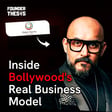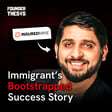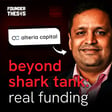
How to Bootstrap a Deep Tech VC fund in India | Ashish Taneja (growX Ventures)
"Cash is just a commodity. What truly attracts top entrepreneurs is the connection you build."
Ashish Taneja completely flips the traditional investor-founder power dynamic in this eye-opening conversation with host Akshay Datt, revealing why the best founders actually choose their investors, not the other way around.
Ashish Taneja is the Founding Partner & CEO of GrowX Ventures, one of India's pioneering deep tech venture capital firms. A Chartered Accountant who transitioned from being the India CEO of Vertex (a major UK BPO firm) to venture investing, Ashish has bootstrapped GrowX from angel investments in 2008 to managing ₹400+ crores across institutional funds. His portfolio includes a spectacular 17x return from spacetech company Pixxel, and notable exits to companies like Reliance and NASDAQ. With 49 investments and 9 successful exits over 15+ years, Ashish has become a leading voice in India's hardware and deep tech ecosystem.
Key Insights from the Conversation:
👉Deep Tech Focus: India's future lies in hardware-first companies solving complex problems in space, defense, semiconductors, and advanced manufacturing
👉Patient Capital Thesis: Deep tech requires 4-6 year investment horizons versus software's 18-month cycles
👉Dual Valley Strategy: Successful deep tech investing means navigating both technology risk and commercialization risk simultaneously
👉Founder-First Philosophy: The best entrepreneurs choose their investors based on value-add, not just capital
👉Barbell Portfolio Strategy: Combining high-risk seed deep tech bets with lower-risk Series B growth investments
👉Bootstrap Mentality: Building a VC fund through personal savings, consulting revenue, and reinvested returns rather than institutional money
#VentureCapital #DeepTech #SpaceTech #HardwareStartups #IndiaVC #StartupFunding #TechInvesting #DefenseTech #Semiconductors #PatientCapital #FounderThesis #AkshayDatt #GrowXVentures #AshishTaneja #StartupEcosystem #AngelInvesting #SeriesB #SeedFunding #TechEntrepreneur #IndianStartups #VCStrategy #InvestmentStrategy #TechFounders #StartupJourney #ModernIndustrials
Disclaimer: The views expressed are those of the speaker, not necessarily the channel



















